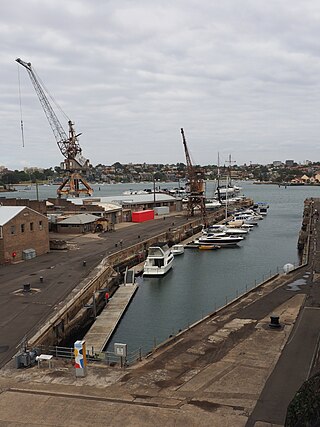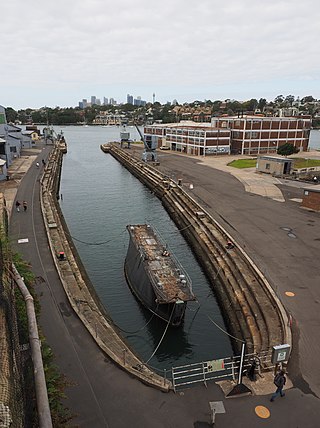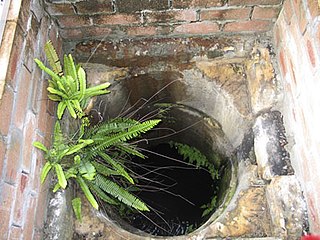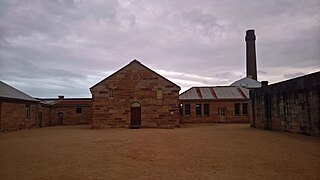
Cockatoo Island is a UNESCO World Heritage Site at the junction of the Parramatta and Lane Cove River in Sydney Harbour, New South Wales, Australia.

Garden Island is an inner-city locality of Sydney, Australia, and the location of a major Royal Australian Navy (RAN) base. It is located to the north-east of the Sydney central business district and juts out into Port Jackson, immediately to the north of the suburb of Potts Point. Used for government and naval purposes since the earliest days of the colony of Sydney, it was originally a completely-detached island but was joined to the Potts Point shoreline by major land reclamation work during World War II.

His Majesty's Naval Base, Portsmouth is one of three operating bases in the United Kingdom for the Royal Navy. Portsmouth Naval Base is part of the city of Portsmouth; it is located on the eastern shore of Portsmouth Harbour, north of the Solent and the Isle of Wight. Until the early 1970s, it was officially known as Portsmouth Royal Dockyard ; thereafter the term 'Naval Base' gained currency, acknowledging a greater focus on personnel and support elements alongside the traditional emphasis on building, repairing and maintaining ships. In 1984 Portsmouth's Royal Dockyard function was downgraded and it was formally renamed the 'Fleet Maintenance and Repair Organisation' (FMRO). The FMRO was privatized in 1998, and for a time, shipbuilding, in the form of block construction, returned. Around 2000, the designation HMS Nelson was extended to cover the entire base.

The Cockatoo Island Dockyard was a major dockyard in Sydney, Australia, based on Cockatoo Island. The dockyard was established in 1857 to maintain Royal Navy warships. It later built and repaired military and battle ships, and played a key role in sustaining the Royal Australian Navy. The dockyard was closed in 1991, and its remnants are heritage listed as the Cockatoo Island Industrial Conservation Area.

The Garden Island Naval Chapel is a heritage-listed non-denominational Christian chapel located in the heritage-listed Garden Island Naval Precinct that comprises a naval base and dockyard in the inner eastern Sydney suburb of Garden Island in the City of Sydney local government area of New South Wales, Australia. Housed in a building designed by James Barnet and built between built 1886 and 1887, the chapel was established in 1902 after conversion from the former sail loft and is the oldest Christian chapel of the Royal Australian Navy (RAN) and has stained glass windows and plaques from that era to the present. The chapel was added to the Commonwealth Heritage List on 22 June 2004 and the New South Wales State Heritage Register on 12 November 2004.

The Hydraulic engine house is part of the "Underfall Yard" in Bristol Harbour in Bristol, England.

Mort's Dock is a former dry dock, slipway, and shipyard in Balmain, New South Wales, Australia. It was the first dry dock in Australia, opening for business in 1855 and closing more than a century later in 1959. The site is now parkland.

Sutherland Dock is a heritage-listed dockyard at the former Cockatoo Island Dockyard, Cockatoo Island, New South Wales, Australia. It was added to the Australian Commonwealth Heritage List on 22 June 2004.

Fitzroy Dock is a heritage-listed dockyard at the former Cockatoo Island Dockyard, Cockatoo Island, Sydney Harbour, New South Wales, Australia. It was added to the Australian Commonwealth Heritage List on 22 June 2004.

South Brisbane Dry Dock is a heritage-listed dry dock at 412 Stanley Street, South Brisbane, City of Brisbane, Queensland, Australia. It was designed by William David Nisbet and built from 1876 to 1887. It is also known as the Government Graving Dock. It was added to the Queensland Heritage Register on 21 October 1992.

Commonwealth Lightship 4 (CLS4) Carpentaria is a lightship that was in service from 1917 to 1985 with the Commonwealth Lighthouse Service, built at the Cockatoo Island Dockyard and commissioned in 1917. The vessel is named after the Gulf of Carpentaria, where it spent most of its service life together with its sister ship CLS2.

The Underground Grain Silos are heritage-listed silos at Cockatoo Island, Sydney Harbour, New South Wales, Australia. It was added to the Australian Commonwealth Heritage List on 22 June 2004.

Biloela House is a house at the centre of a heritage-listed historic precinct on Cockatoo Island, Sydney Harbour, New South Wales, Australia. It was added to the Australian Commonwealth Heritage List on 22 June 2004.

Prison Barracks Precinct is a heritage-listed prison precinct at Cockatoo Island, Sydney Harbour, New South Wales, Australia. It was added to the Australian Commonwealth Heritage List on 22 June 2004.

Convict Barracks Block is a heritage-listed convict barracks within the Prison Barracks Precinct, Cockatoo Island, Sydney Harbour, New South Wales, Australia. It was added to the Australian Commonwealth Heritage List on 22 June 2004.

Military Guard Room is a heritage-listed military installation within the Prison Barracks Precinct, Cockatoo Island, Sydney Harbour, New South Wales, Australia. It was added to the Australian Commonwealth Heritage List on 22 June 2004.

Mess Hall is a heritage-listed part of the Prison Barracks Precinct at Cockatoo Island, New South Wales, Australia. It is also known as Mess Hall (former). It was added to the Australian Commonwealth Heritage List on 22 June 2004.

Cockatoo Island Industrial Conservation Area is a heritage-listed protected area relating to the former Cockatoo Island Dockyard at Cockatoo Island, Sydney Harbour, New South Wales, Australia. It was added to the Australian Commonwealth Heritage List on 22 June 2004.

The Ultimo Sewage Pumping Station is a heritage-listed sewerage pumping station located at William Henry Street in the inner city Sydney suburb of Ultimo in the City of Sydney local government area of New South Wales, Australia. As a result of the construction of an elevated roadway along William Henry Street, the pumping station now fronts Pyrmont Street, with vehicles being required to enter via Quarry Street, then turning right into Pyrmont Street.

The Garden Island Naval Precinct is a heritage-listed naval base and defence precinct located at Cowper Wharf Roadway in the inner eastern Sydney neighbourhood of Garden Island in the City of Sydney local government area of New South Wales, Australia. The precinct was built from 1856. It includes the HMAS Kuttabul naval base, formerly known as HMAS Penguin. The property is owned by Australian Department of Defence. It was added to the Commonwealth Heritage List on 22 June 2004 and the New South Wales State Heritage Register on 12 November 2004.





















